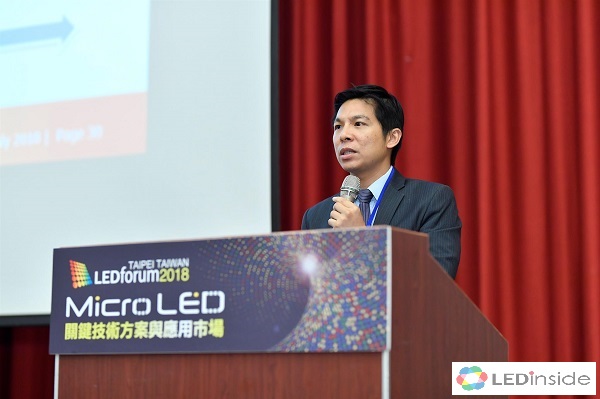Micro LEDforum 2018 was held successfully yesterday on July 12th in Taipei. Nearly 300 attendees from all over the world joined the giant annual event to learn the trends of the industry and to spark idea exchanges as well as to find the opportunities for business cooperation. LEDinside was honored to invite speakers from leading institutes including eLux, Uniquarta, QMAT, KIMM, Nitride Semiconductors, V-technology, Topcon, Macroblock, KLA, SelfArray and Jasper Display to share their technologies and insights of Micro LED.
Roger Chu, the Research Director of LEDinside, gave an open speech to warm up the forum and disclosed his understandings of the current development of Micro LED and Mini LED as well as progress of end-products applications. Micro LED performs better in response time, viewing angle, color display, contrast and energy consumption in comparison with LCD and OLED. Big names like Apple, Sony and Samsung have been pushing the application for end-market. According to the latest report of LEDinside, the market value of Micro LED and Mini LED products is estimated to be US$1.38 billion by 2022.

(Roger Chu, the Research Director of LEDinside)
According to Chu, the cost is still the main issue of Micro LED display. At the moment, leading brands will most likely begin with extra-large displays (bigger than 100-inch) targeting the high-end market in the Middle East and North America such as The Wall of Samsung and CLEDIS of Sony. The companies are preparing themselves by starting with the gigantic size TV, and then once the technology is more mature and the cost is easier to control, they can enter the mainstream size display market. The ultra-large size TVs are expected to be launched later this year but for smaller size displays, it might take at least three years depending on the progress of different companies.
AR projection is another application that Micro LED would be compatible with, as currently the main issue for AR projection is lack of brightness. The self-emitting and high brightness features of Micro LED can provide better solutions and therefore will become an option for companies like Apple if it plans to launch wearable devices adopting AR projection.
As for smart phone and tablet, it is difficult for Mini and Micro LED to enter the markets not because of the technology but because of the cost. Since OLED has been a mature technology for display application, currently Mini and Micro LED are too costly to be applied in mobile devices compared to OLED.
However, as more and more companies are putting efforts in the development of Micro LED, the technology progress might be faster than expected once the manufacturing process and yield are improved, said Chu.
To collect and share more insights of Micro LED technologies, LEDinside is currently hosting 2018 Micro LED Technology Research Contest and would like to invite companies, academic institutions and other corporate entities to submit abstracts or outlines of their latest technical papers related to innovative Micro LED technologies. For more details, please visit: LEDinside " Micro LED Technology Competition" Calls for Paper Abstracts.













